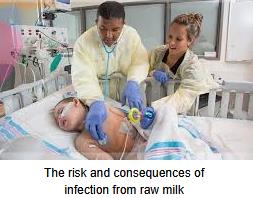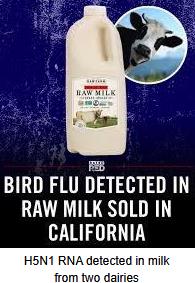Dr. Lisa Santora, Public Health Officer for Marin County, California has urged consumers to avoid raw milk products. This follows a suspected case of H5N1 influenza in a child that consumed milk from raw milk dairy. The child recovered, but laboratory evaluation of specimens failed to confirm that the provisional diagnosis. This does not necessarily exclude the possibility of H5N1 infection since demonstration of viral RNA by PCR depends on the presence of the virus at a time when samples are obtained. California has recorded 32 confirmed cases of avian influenza H5N1, mainly in workers involved in depopulation of flocks or milking cows in herds known to be infected with H5N1. The affected child did not have a history of exposure to either live dairy cattle or poultry. The Santa Clara County Public Health Agency demonstrated the presence of viable H5N1 virus in raw milk supplied by Raw Farm in late November leading to a recall.

As bovine influenza-H5N1 is prevalent in California dairy herds with more than 640 having been identified mainly through mandatory bulk milk surveillance. Although infected lactating cows generally recover from transient infection within two weeks, milk yield and quality may be irreversibly affected. In California, cattle in affected herds subjected to heat and other stress showed elevated mortality.
USDA has demonstrated that pasteurization effectively inactivates H5N1 virus. Pasteurization will also eliminate Salmonella, Listeria, E. coli, Campylobacter, and other bacterial pathogens.
Along with public health experts, Dr. Santora was careful to express the opinion that risk to the public remains low since there is no evidence of contagion (human-to-human spread).
Evaluation of viral isolates from affected poultry and dairy workers has demonstrated a mutation that allows the virus to attached to human respiratory cells. Additional mutations would be required to create a zoonotic strain that is also contagious among humans.

Suppression of infection in poultry flocks and dairy herds will limit the probability of mutations. Biosecurity has proven to be less than totally effective and obviously should be reinforced by vaccination as applied in China, Mexico and France.
Consumption of raw milk is associated with a disproportionate probability of infection with known bacterial pathogens compared to pasteurized fluid milk and derived products including cheese.
Given the “freedom to be infected” principle, adults who are eiter informed or ignorant of risks can make their own choice as to consumption of raw milk. Supplying raw milk to children is effectively a form of abuse.